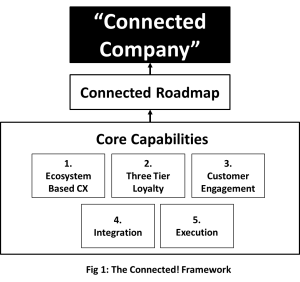Preparing for the connected future will have a far reaching and profound impact on our organizations. We cannot not change how we work, and how we think, and still expect to be creating magic with our customers.
 The framework that I detail in the book “Connected!” provides a simple and immediately actionable blueprint. It consists of defining what a connected company is, and 5 important capabilities to support the vision.
The framework that I detail in the book “Connected!” provides a simple and immediately actionable blueprint. It consists of defining what a connected company is, and 5 important capabilities to support the vision.
What is a connected company?
The philosophy of being a connected company relates to an expansion of what we consider as boundaries or limits of our products and resulting customer experiences. Physical boundaries between industries are falling. Measuring ourselves on digital capabilities for distribution and access to our products alone is an approach that is strikingly inadequate for the future. We must instead look at the entire customer engagement ecosystem. We must think of our own products portfolio as an extension of the ecosystem. That is not an easy evolution. But its becoming easier today with technology. Think of voice activated devices or chatbots that can connect with your bank and book your flights for you. Or cars fitted with advanced technology that can drive themselves too. Or how Apple is bringing the power of loyalty programs right at the point of sale. These are just the beginnings of this exciting trend.
As a result, the entire concept of digital maturity assessment must change. While individual portfolios and channels can still apply the traditional definition of digital maturity, those parameters are no longer very useful in defining overall competitiveness. To summarize, digital strategy is not about our digital capabilities, but instead it’s about defining how to compete in a digital world.
The 5 capabilities necessary to be a “connected company” are:
- Block 1: The concept of Ecosystem based CX shows us how we should be building customer journeys that span not only our channels and products, but instead focus on the customer and leverage the power of our ecosystem. This means that an inside-out customer journey that shows customers interactions and touchpoints with our channels and products across the purchase lifecycle are no longer adequate. We must look outside-in.
- Block 2: The 3 Tier Connected Loyalty model will outline how the concept of loyalty has to tap into customer aspirations and motivations and how to extend the loyalty and rewards model to span the connected ecosystem. This approach also helps reduce the “cost of loyalty” while adding greater value to our customers.
- Block 3: The connected model of Customer Engagement shows us how emotional and physical engagement touchpoints should and can complement each other. It also shows how to reinforce customer confidence in our brand so we can become a reference anchor in our customers’ minds by being an advice engine. And it shows how to do that the ecosystem we define and evolve for ourselves.
- Block 4: The connected model of Integration is about how we present ourselves to our customers to build lasting and meaningful customer relationships. It will show us how we need to unify the combined appeal of all our products and services. In addition, this capability will show us how to extend the value of our portfolio by bringing the power of our ecosystem to our customers.
- Block 5: The Execution capability will perhaps clarify the biggest challenge facing leaders today – how to execute and thrive in a new connected world. This block combines various techniques and outlines practical methods to get going and build on the momentum, We will explore the concept of creating and leveraging Connected Communities, what a CX focused organizational design looks like, and how the traditional concept of the balanced scorecard model should be adapted to turn our companies into connected powerhouses.
Now that we have a blueprint of what it means to be a connected company, explore these in more detail. Get your own copy of Connected! here.
